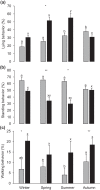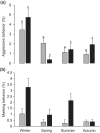The environment matters: season and female contact affect the behavior of captive Addax nasomaculatus male antelope
- PMID: 37261311
- PMCID: PMC10078014
- DOI: 10.1007/s10211-023-00419-3
The environment matters: season and female contact affect the behavior of captive Addax nasomaculatus male antelope
Abstract
The addax antelope (Addax nasomaculatus) is a species under serious threat of extinction, as it is more abundant in captivity than in the wild. However, little is known about its basic biology. The aims of this study were to determine how locomotor, feeding, aggressive, marking, and sexual behavior of male addax allocated in all-male groups vary with season and with female contact (i.e., biostimulation). The study was conducted in captive conditions, in two groups of adult males: one with no-physical contact with females, aside from visual and olfactory interactions (CF group, n = 4), and another group completely isolated from females (IF group, n = 4). The frequency of behaviors was recorded during the daytime, 4 days per season (total time of observation = 256 h). Lying, standing, walking, aggressive, marking, grazing, and ruminating behaviors as well as water and supplement consumptions varied with season (all p < 0.05). The lying, walking, marking, grazing, and ruminating behaviors were more frequently observed for CF than IF males (all p < 0.05). Also, all behaviors, except for marking, varied with the interaction between the group and seasons (all p < 0.05). Sexual behavior was extremely scarce, so it was not possible to analyze how it varied with seasons and the group. The present study suggests that management program and housing conditions, especially in ex situ breeding plans, should consider the influence of the season and the sociosexual context on the behavior of addax males.
Keywords: Biostimulation; Endangered; Ex situ conservation; Female effect; Ruminant.
© The Author(s) under exclusive licence to ISPA, CRL 2023, corrected publication 2023. Springer Nature or its licensor (e.g. a society or other partner) holds exclusive rights to this article under a publishing agreement with the author(s) or other rightsholder(s); author self-archiving of the accepted manuscript version of this article is solely governed by the terms of such publishing agreement and applicable law.
Conflict of interest statement
Conflict of interestThe authors declare no competing interests.
Figures



Similar articles
-
Genetic diversity in global populations of the critically endangered addax (Addax nasomaculatus) and its implications for conservation.Evol Appl. 2022 Dec 21;16(1):111-125. doi: 10.1111/eva.13515. eCollection 2023 Jan. Evol Appl. 2022. PMID: 36699120 Free PMC article.
-
A suite of microsatellite markers optimized for amplification of DNA from Addax (Addax nasomaculatus) blood preserved on FTA cards.Zoo Biol. 2012 Jan-Feb;31(1):98-106. doi: 10.1002/zoo.20420. Epub 2011 Sep 6. Zoo Biol. 2012. PMID: 21898577
-
Diversity and Paleodemography of the Addax (Addax nasomaculatus), a Saharan Antelope on the Verge of Extinction.Genes (Basel). 2021 Aug 11;12(8):1236. doi: 10.3390/genes12081236. Genes (Basel). 2021. PMID: 34440410 Free PMC article.
-
Fluid and particle retention in the digestive tract of the addax antelope (Addax nasomaculatus)--adaptations of a grazing desert ruminant.Comp Biochem Physiol A Mol Integr Physiol. 2008 Feb;149(2):142-9. doi: 10.1016/j.cbpa.2007.11.001. Epub 2007 Nov 13. Comp Biochem Physiol A Mol Integr Physiol. 2008. PMID: 18083600
-
Is it time to reconsider the relative weight of sociosexual relationships compared with photoperiod in the control of reproduction of small ruminant females?Domest Anim Endocrinol. 2020 Oct;73:106468. doi: 10.1016/j.domaniend.2020.106468. Epub 2020 Mar 5. Domest Anim Endocrinol. 2020. PMID: 32249000 Review.
References
-
- Akaike H (1974) A new look at the statistical model identification. IEEE Trans. Automat. Contr 19:716–723. 10.1109/TAC.1974.1100705
-
- Alvarez F. Risks of fighting in relation to age and territory holding in fallow deer. Can J Zool. 1993;71:376–383. doi: 10.1139/z93-052. - DOI
-
- Bronson FH. Mammalian reproductive biology. Chicago: The University of Chicago Press; 1989.
LinkOut - more resources
Full Text Sources
Miscellaneous
